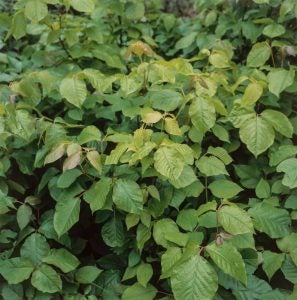Be alert to dangers of autumn
Published 4:50 pm Friday, November 8, 2019

- Like the ivy and oak, poson sumac leaves display an attractive array of fall attire. The stems along the leaflets are red and the leaves can have a reddish tint to them, particularly at the top of the plant. Courtesy | Shutterstock
By Kristi Hendricks
Home gardeners need beware the dangers of autumn! Despite the gorgeous fall foliage of certain plants, keep your distance or be armed with the right equipment and apparel to tackle these irritable plants. Otherwise you may find yourself with a case of the blisters, swelling and extreme itch from the close contact with poison ivy, oak and sumac.

Climbing Eastern poison ivy can grow as groundcover, a small bush or even a trailing vine traveling up unsuspecting trees, road signs and porch railings. Courtesy | Shutterstock
As children, we learned to heed the warning “leaves of three, let it be.” Eastern poison ivy is the most common of these three worrisome plants. Toxicodendron radicans can grow as groundcover, a small bush or even a trailing vine traveling up unsuspecting trees, road signs and porch railings. Much like English ivy, poison ivy has troublesome fuzzy, aerial roots that assist this plant to cling to bark, wood and mortar.
Look to the leaves to identify this plant. Leaflets grow in clusters of three with the middle leaf largest. The leaf edges can be smooth or toothed. Green summer foliage transitions to a brilliant fall collage of red, yellow and orange.
Later in the season, clusters of yellowish, berry-like drupes form. These fruits are an important food source for birds, but suggest you don’t decorate your door wreath with its tendrils as all plant parts are poisonous to humans except for a small percentage of people who are immune to poison ivy’s toxin.

Atlantic poison oak takes on a shrub form that tends to grow in dryer and less fertile soil conditions than poison ivy. Courtesy | Shutterstock
Atlantic poison oak, T. pubescens, takes on a shrub form that tends to grow in dryer and less fertile soil conditions than poison ivy. Unlike the ivy, the oak has a non-climbing growth habit. Its leaflets are usually hairy and often resemble the leaves of white oak trees, hence the common name. These leaves turn yellow or orange in autumn. Plant fruits are small, round and greenish tan.
Poison sumac, T. vernix, is a small tree that infrequently grows in the acidic, moist bogs of southern and eastern Virginia. Like the ivy and oak, sumac leaves display an attractive array of fall attire. The stems along the leaflets are red and the leaves can have a reddish tint to them, particularly at the top of the plant. Poison sumac fruits are creamy white and form a cluster. This plant is appropriately known as thunderwood in the Southeast.
Avoid breathing the smoke of burning leaf or brush piles if these plants are present as the fumes carry the irritating oily sap compound called urushil. All three are in the Anacardiaceae family of flowering plants known as the cashew or sumac family. Not all plants in this family cause skin irritations.
Home gardeners take stock of other poison plants native to the Southside as identified in Master Naturalist article “The Socrates Project,” CNRE-21, located at pubs.ext.vt.edu/.





